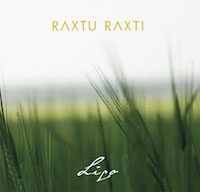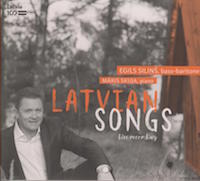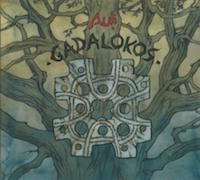Raxtu raxti, a group that melds Latvian folk styles and performances with popular songs, has quickly become one of the most popular groups in Latvia. Their 2015 album Es atradu tautasdziesmu, where they mostly performed the songs of composer Imants Kalniņš, but with folk influenced arrangements, was one of the highlights of the Latvian music world that year. After many successful performances in Latvia, the group quickly returned to the studio to record their follow-up.
This time, the group decided to record an album of songs based around the Latvian midsummer festival Jāņi, which resulted in the album simply and appropriately titled Līgo. Featuring songs inspired by this celebration, the album is again a combination of traditional sounds and lyrics with contemporary performances and arrangements.
Raxtu raxti is made up of both well-known folk musicians as well as members of the Latvian pop group Autobuss debesīs. On Līgo, the musicians are Kristīne Kārkle on vocals and violin, Marts Kristiāns Kalniņš (vocals, keyboards), Edgars Kārklis (vocals, bagpipes), Kārlis Auzāns (cello, guitar), Armands Treilihs (drums) and are joined by Artis Orubs (percussion) and Ilze Grunte (guitar). And, as on their debut album, this collection of musicians from different musical genres turns in a winning performance.
As the Midsummer festival is, at its foundation, a pagan festival, the songs presented on the album tend more towards the mystical aspects of the celebration. This becomes evident starting with the first song, “Lec saulīte”, which is introduced by Kārkle’s echoing vocals. The song, with folk lyrics and music by Marts Kristiāns Kalniņš, is about the tradition of waiting for the sun to rise on the morning of June 24th, and captures the magic of that moment.
The celebratory aspect of Midsummer is presented in “Es dziedāju, gavilēju”, with its enthusiastic pronouncement of “Pļavas mežus skandēdami, Jāņu dienu gaidīdam’” (The fields and forests resounded as we waited for Midsummer) are supplemented by Kārkle’s violin to make for a particularly joyous performance.
The fantastic legends of Midsummer night are the basis for the energetic “Bur man burvji, skauž man skauģi” (folk song lyrics with music by Kārlis Auzāns), a song of conjuring and protecting one’s homestead against the witches, warlocks and other jealous types that ride during the night. The song, a duet of Kalniņš and Kārkle, weaves a memorable musical vision of this battle with evil spirits.
The song “Parādies(i), tu, Saulīte” with its driving drums, might remind some of the bagpipe and drum ensemble Auļi, which is not particularly surprising, as Edgars Kārklis also plays bagpipes in Auļi. The songs of Auļi are also often based on Latvian traditions and folk beliefs, and this also shines through this song about summoning the sun to appear.
Releasing an album of just Jāņi songs could be considered limiting, if not a bit of a risk, as many Midsummer folk songs are not that familiar to most listeners (considering the multitude of songs, only a handful are comparatively well known). Also, some might think that the material for the songs is limited (how many songs can you sing about the sun, fire, beer and, sometimes, cheese?) Still, Raxtu Raxti show that there is quite the depth of thematic material to present to listeners, and that there is a wealth of imagery and styles that can be shown.
Showing that their debut album was no fluke, Līgo, Raxtu Raxti’s second album, reinforces the notion that the group is one of the most notable ensembles in Latvia today. Līgo presents an engaging and memorable musical tapestry of Midsummer, the shortest night in the calendar. Combining both elements of Latvian folklore and legends, along with adept and engaging musicianship, the album is a creative and enjoyable tour of this Latvian celebration.
For further information, please visit the Raxtu Raxti Facebook page.
Raxtu raxti
Līgo
Premium Art, PA3, 2016
Track listing:
- Lec, Saulīte!
- Kad Saulīte meita bija
- Rūgtin’ grūga alutiņ(i)s
- Saules meita jostu auda
- Līdz pašam(i) Ziemeļam
- Klusi, klusi
- Es dziedāju, gavilēju
- Visu gadu Jānīts jāja
- Bur man burvji, skauž man skaugi
- Dedziet gaišu Jāņu guni
- Parādies(i), tu, Saulīte
- Saule nāca līgodama






